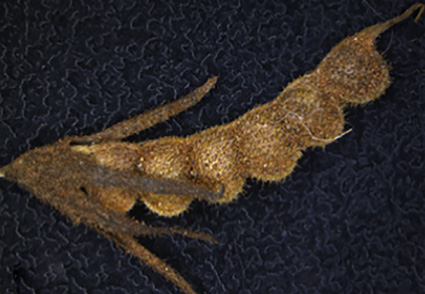Abstract
A revisional taxonomic study of Adesmia subg. Adesmia ser. Bicolores has unveiled a new species from southern Brazil. Adesmia miottoae is described and illustrated here. Its geographic distribution, phenology, conservation status and morphological similarities with its closest relatives, Adesmia punctata and A. incana, are presented. The species is distinguished by glandular trichomes covering all the aerial parts of the plant, except the corolla. These trichomes are shorter than those of Adesmia punctata. Additionally, a detailed anatomical description of the leaflet blade is provided.
References
Bukatsch, F. (1972) Bemerkungenzur doppelfarbung: astrablau-safranin. Mikrokosmos 61: 255.
Burkart, A. (1967) Sinopsis del género sudamericano de Leguminosas Adesmia DC. (Contribución al estudio del género Adesmia VII). Darwiniana 14: 463–568.
Davyt, M. & Izaguirre, P. (1996) Sinopsis de las espécies y variedades del género Adesmia DC. (Fabaceae–Adesmieae) en el Uruguay. Parodiana 9: 89–114.
De Candolle, A.P. (1825) Notes sur quelques genres et especes nouvelles de Légumineuses. Annales des Sciences Naturelles (Paris) 4: 94–95.
ESRI (2016) ArcGIS. Environmental Systems Resourse Institute, Redlands, California.
Fortuna-Perez, A.P., Silva, M.J., Queiroz, L.P., Lewis, G.P., Simões, A.O., Tozzi, A.M.G.A., Sarkinen, T. & Souza, A.P. (2013) Phylogeny and biogeography of the genus Zornia (Leguminosae: Papilionoideae: Dalbergieae). Taxon 62: 723–732. https://doi.org/10.12705/624.35
Fortuna-Perez, A.P., Marinho, C.R., Vatanparast, M., Vargas, W., Iganci, J.R.V., Lewis, G.P., Cândido, E.S., Moura, T.M., Monteiro, T.C., Miotto, S.T.S. & Teixeira, S.P. (2021) Secretory structures of the Adesmia clade (Leguminosae): Implications for evolutionary adaptation in dry environments. Perspectives in Plant Ecology, Evolution and Systematics 48: 125588. https://doi.org/10.1016/j.ppees.2020.125588
Gmelin, J.F. (1791) Systema Naturae, Tomo II. Leipzig. 1661 pp.
Hasenack, H., da Silva, J.S., Weber, E. & Hofmann, G.S. (2017) A digital version of Hueck’s vegetation map of South America: 50 years after the release of his book on the sub-continent’s forests. Geografía y Sistemas de Información Geográfica (GEOSIG) 9: 1–5. [ISSN 1852-8031; http://www.gesig-proeg.com.ar]
Iganci, J.R.V., Miotto, S.T.S., Souza-Chies, T.T., Särkinen, T.E., Simpson, B.B., Simon, M.F. & Pennington, R.T. (2013) Diversi?cation history of Adesmia ser. Psoraleoides (Leguminosae): Evolutionary processes and the colonization of the southern Brazilian highland grasslands. South African Journal of Botany 89: 257–264. https://doi.org/10.1016/j.sajb.2013.06.016
IUCN Standards and Petitions Subcommittee (2019) Guidelines for Using the IUCN Red List Categories and Criteria. Version 14. Prepared by the Standards and Petitions Subcommittee. Available from: http://www.iucnredlist.org/documents/RedListGuidelines.pdf (accessed 27 March 2019)
Jacquin, N.J. (1760) Enumeratio Systematica Plantarum, quas in insulis Caribaeis. Zug, 41 pp. https://doi.org/10.5962/bhl.title.100687
Jensen, W.A. (1962) Botanical Histochemistry Principles and Practice. San Francisco: W. H. Freeman and CO. JSTOR – Global Plants, Available from: https://plants.jstor.org/ (Accessed 11 Febuary 2021).
Klitgaard, B. & Lavin, M. (2005) Tribe Dalbergieae. In: Lewis, G. Schrire, B. Mackinder, B. & Lock, M. Legumes of the World. Royal Botanic Gardens, Kew, London, pp. 307–335.
Kunth, C.S. (1824) Nova Genera et Species Plantarum, tomo VI. Paris, 600 pp.
Lavin, M., Pennington, R.T., Klitgaard, B.B., Sprent, J.I., Lima, H.C. de & Gasson, P.E. (2001) The Dalbergioid legumes (Fabaceae): delimitation of a pantropical monophyletic clade. American Journal of Botany 88: 503–533. https://doi.org/10.2307/2657116
Miotto, S.T.S. (1991) O gênero Adesmia DC. (Leguminosae–Faboideae) no Brasil. P.H.D. Thesis. Universidade Estadual de Campinas, Campinas, 307 pp.
Moura, T.M. Gereau, R.E. Särkinen, T.E. & Fortuna-Perez, A.P. (2018) A New Circumscription of Nissolia (Leguminosae Papilionoideae-Dalbergieae), with Chaetocalyx as a New Generic Synonym. Novon 26 (2): 193–213. https://doi.org/10.3417/2018037
O’Brien, T.P., Feder, N. & Mccully, M.E. (1964) Polychromatic staining of plant cell walls by toluidine blue O. Protoplasma 59: 368–373. https://doi.org/10.1007/BF01248568
Poiret, J.L.M. (1804) In: Lamarck, M. Encyclopédie méthodique Botanique 6: 395–449.
Reflora Herbário Virtual. (2021) Available from: http://reflora.jbrj.gov.br/reflora/herbarioVirtual (Accessed 11 Febuary 2021)
Smith, F.H. & Smith, E.C. (1942) Anatomy of the inferior ovary of Darbya. American Journal of Botany 29: 464–471. https://doi.org/10.1002/j.1537-2197.1942.tb10236.x
Sprengel, C. (1826) Systema Vegetalibium, tomo III. Gottingen, 936 pp.
Thiers, B. (2020) [continuously updated] Index Herbariorum: A global directory of public herbaria and associated staff. New York Botanical Garden’s Virtual Herbarium. Available from: http://sweetgum.nybg.org/science/ih/ (accessed 22 September 2021)
Ulibarri, E.A. & Burkart, A. (2000) Sinopsis de las especies de Adesmia (Leguminosae-Papilionoideae) de la Argentina. Darwiniana 38: 59–126.
Ventenat, E.P. (1807) Notice surr les plantes qui seront publiées dans les cinq dernières livraison de l’ouvrage intitulée “Choix des plantes”. Mémoires de la Classe des Sciences, Mathematique et Physique de l’Institut National de France, Paris 8: 4–6.
Vogel, T. (1838) Adesmia. Linnaea 12: 72–81.


